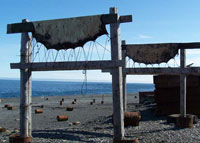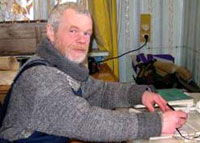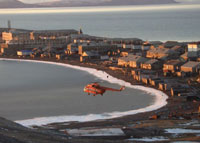 Many people from Russia and around the world dream of visiting Cape Dezhnev, the farthest eastern point of Eurasia. From here, with the Bering Strait spreading at your feet, the closest distance to the Unites States is 80 km. The feeling of endlessness is enormous. If you think of yourself as a romantic, this is the place for you.
Many people from Russia and around the world dream of visiting Cape Dezhnev, the farthest eastern point of Eurasia. From here, with the Bering Strait spreading at your feet, the closest distance to the Unites States is 80 km. The feeling of endlessness is enormous. If you think of yourself as a romantic, this is the place for you.
Uelen (older name Ulyk; also known as Olyk in Yupik Eskimo and Pok’ytkyn in Chikchi, translated as “the land’s end” and “flooded place,” respectively). In the Western explorer history, the first mention of Uelen appears on the 1792 map of the Billings-Sarychev expedition. Archeological data suggests that Uelen was initially an Eskimo settlement, but at the beginning of XVIII century the incoming Chukchi settlers outnumbered the prior occupants and assimilated the territory of Cape Dezhnev. Now it is a large modern Chukchi community with population around 680 inhabitants. The village has local administrative offices, a boarding school, day care, weather station, and an agricultural enterprise. World over, Uelen is famous for its Carving Workshop, founded in the 1930s, which employs a number of award-winning Chukotka Native artists. Masterpieces from the Uelen Studio, carved from walrus ivory, sea-mammal bone, and reindeer antler are represented in the many major museums and art collections.
 Victor Struzhikov is a state inspector who monitors the Uelen area of the Park.
Victor Struzhikov is a state inspector who monitors the Uelen area of the Park.
Uelen area is bounded by the coast and waters of the Bering Straight, from the mouth of Rybnaya River to Cape Dezhnev. Within the Chukchi Sea, it stretches from Cape Dezhnev to the western side of the Uelen spit.
Among the marine mammals found in this area are gray whale, bowhead whale, and bearded seal. The land animals include wolf, wolverine, arctic fox, polar bear, fox, and mountain hare. There are such birds as common murre, willow ptarmegan, gyrfalcon, and raven. People fish for arctic char, arctic cod, arctic flounder, fourhorn sculpin, and saffron cod.
 Uelen area is famous for its archeological monuments:
Uelen area is famous for its archeological monuments:
• The Uelen burial ground is one of the largest and most significant cultural resources on the Chukchi Sea coast.
• Chukchi settlement Dezhnevo which appeared at the end of the 19th century. Its inhabitants moved to Uelen in 1951.
• The Ekven burial, located near Cape Verbluzhy, is one the ancient sites representing the Old Bering Sea culture.
• Naukan is an archeologically complex, multi-layer settlement, sharing its site with the Dezhnev lighthouse. Its history begins around 11-12 A.D, making Naukan the oldest Eskimo settlement on Chukchi Sea coast. In the 1940s, prior to the settlement closure and relocation, Naukan was inhabited by 337 people. The community was closed in 1958.
• Cape Dezhnev, usually the sunniest point of the Uelen area. It carries the name of Semen Dezhnev, the first Russian explorer of Siberia to travel this far northeast, who came to this area in 1648. Earlier this site was known among the Native people under the names of Big Stone Nose or Chukchi Nose. In 1879, Finnish Polar explorer Nordensheld proposed to name it Cape Dezhnev in honor of the 250-year anniversary of its discovery by the famous Cossack.
